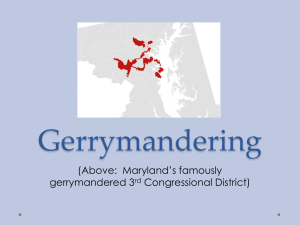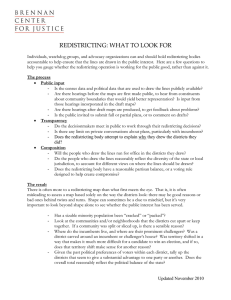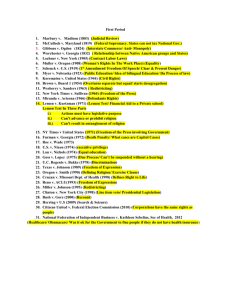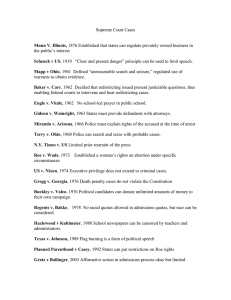102A AMERICAN BAR ASSOCIATION ADOPTED BY THE HOUSE OF DELEGATES
advertisement
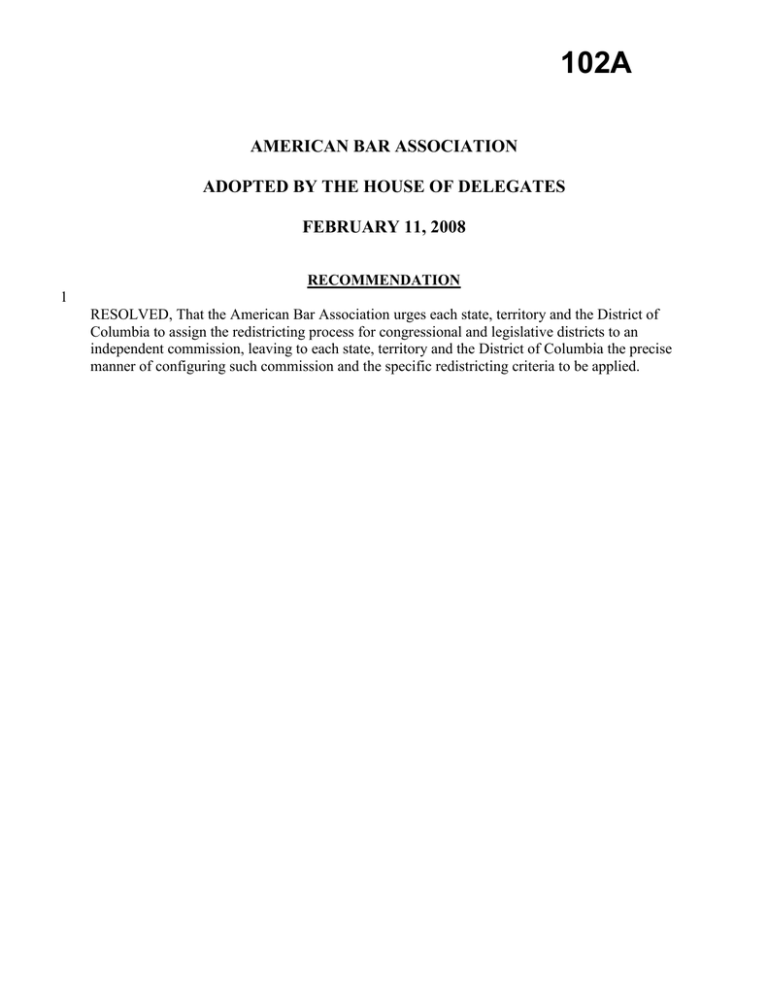
102A AMERICAN BAR ASSOCIATION ADOPTED BY THE HOUSE OF DELEGATES FEBRUARY 11, 2008 RECOMMENDATION 1 RESOLVED, That the American Bar Association urges each state, territory and the District of Columbia to assign the redistricting process for congressional and legislative districts to an independent commission, leaving to each state, territory and the District of Columbia the precise manner of configuring such commission and the specific redistricting criteria to be applied. 102A REPORT I. INTRODUCTION Redistricting in the United States is the process of redrawing the boundaries of state and federal legislative districts. Redistricting is conducted in each state by either the state legislature or a commission, and normally occurs every 10 years following the U.S. Census. The process is essential to ensuring fair and appropriate representation at both the state and federal levels as required by the Constitution. However, despite its importance, the redistricting process is inherently a political one and can be manipulated by both partisan and bipartisan forces. Gerrymandering—redistricting for political advantage—is used both by partisans seeking to gain additional seats and by bipartisan incumbents seeking to shore up their districts and minimize the risk of electoral defeat. Gerrymandering can have—and in many cases has had—several adverse effects on the democratic process. First, it has resulted in a decline in the number of competitive seats throughout the U.S. For example, it has been widely reported that the 2002 congressional elections were the least competitive in modern history. Only 40 – plus or minus a few – out of 435 House races were considered close enough going into election night that the outcome was not known with a high degree of certainty. This lack of competition reduces accountability and threatens to further the already-prickly ideological polarization of our elected officials by enabling the election of partisans who need not appeal to moderate voters.1 It may also minimize voter interest and reduce turnout in noncompetitive districts. Second, gerrymandering can poison the atmosphere in the state legislatures that design and enact the plans, leading to partisan strife and stagnation. In order to effectively improve the redistricting process, the redistricting power must be removed from partisan hands and assigned to independent commissions. The term “independent” as set forth in the resolution is intended to connote the commission’s independence from other political institutions, not to preclude members affiliated with political parties from participation in the redistricting process, and thus is preferable to “nonpartisan” or “bipartisan.” A commission that is independent in this sense should be subject to fewer partisan pressures than are inherent in the redistricting process when conducted by state legislatures. Thus, the resolution calls for a commission that is not in the control of one political party, as is typically the case now, for example, in states where both the legislature and governorship are all in the hands of one party. An independent commission is the best vehicle to ensure that the principles of transparency, effective public participation and accountability are respected as redistricting maps are considered and selected. Twelve states presently conduct their redistricting efforts by some form of independent board or commission.2 1 Thomas E. Mann, Redistricting Reform, THE NATIONAL VOTER, June 2005. These twelve states are: Alaska, Arizona, Arkansas, Colorado, Hawaii, Idaho, Missouri, Montana, New Jersey, Ohio, Pennsylvania, and Washington. 2 2 102A There are two very different models of “independent” redistricting commissions. The first model equates “independence” with nonpartisanship, and suggests that redistricting should be made apolitical. Self-interested political actors should be replaced by neutral redistricters, who are then shielded from the kinds of influences and data that might “re-politicize” the process. The second model, which equates “independence” with bipartisanship (at least in a two-party system such as ours), suggests that redistricting is inherently, indeed inescapably, political, but seeks to minimize unfairness by transferring the redistricting power from legislative bodies — which at any given time may be dominated by one political party — to balanced, bipartisan commissions, where both major parties are ensured an equal number of seats at the bargaining table.3 The choice between these two models will drive many other considerations when crafting state constitutional amendments or statutes creating independent redistricting commissions. Non-Partisan Commission: If the goal is to make the process nonpartisan or apolitical, then elected officials, party officers, and those who work closely with them, cannot serve as commissioners. And commissioners also must be “sealed off” from certain types of information, including most electoral data. As a practical matter, efforts to deny decision-makers relevant information may well raise the risk of corruption – as cheaters who break the rules and obtain the prohibited data will gain a systematic edge over commissioners who follow the rules. Bipartisan Commission: On the other hand, if the goal of creating an independent redistricting commission is conceived more narrowly, so as to focus on preventing extreme partisan gerrymanders, then there is considerably greater flexibility regarding the composition of the commission, the criteria it may apply, and the data it may consider when seeking to satisfy those criteria. Elected officials, party officers, and even political consultants can serve as highly knowledgeable commissioners, so long as both major political parties have the same opportunity to appoint them, in equal numbers. Redistricting with a bipartisan commission can be overtly, and transparently, political – for example, taking into account the massive electoral advantages held by incumbents, rather than pretending that they do not exist. And all manner of relevant data – including detailed, precinctlevel returns from recent elections – are fair game. This model reduces the need to police the commissioners as it eliminates censorship of sensitive political information. In terms of membership, this bipartisan model only demands an equal number of seats for the two major parties. How many commissioners each party gets to appoint, and whether the state party chairs, the legislative leaders, or statewide elected officials (Governor, Attorney General, etc.) have the power to appoint are important questions best left to the states. So too is the important question of whether to include a tie-breaker, and what power to assign that person. The resolution does not take a position on which type of commission (nonpartisan or bipartisan) should be selected within the states. Moreover, independence is only one aspect of a commission’s character. Size, representational composition, qualifications, restrictions on past Iowa’s redistricting (which does not actually involve a “commission” but instead is done largely by legislative staff) suggests that, under certain circumstances, the nonpartisan model may be feasible. But the Iowa example cannot easily be transferred to other states that have more combative political cultures, less tradition of professional nonpartisan legislative staffing, more convoluted political-subdivision lines, and more Voting Rights Act issues. 3 3 102A or future candidacy, decisionmaking methods and other such concerns are also critical details that need to be addressed in establishing an independent redistricting commission. Like the type of independent commission to be established, the resolution leaves these matters to be addressed state by state to reflect political realities. The resolution urges each state not only to adopt procedures for the appointment of independent commissions, but to appoint commissioners who will apply specific redistricting criteria. The resolution does not specify which criteria should be followed within each state because that is a decision which will necessarily vary from state to state. Many states, for example, already have redistricting criteria set forth in the state constitution or prescribed by statute. An illustrative, but not exhaustive, list of such redistricting criteria includes: respect for political subdivisions, respect for communities of interest, encouraging geographical compactness, respect for natural geographical features and barriers, promoting competitiveness, and partisan fairness. And, of course, adherence to the U.S. Constitution and the Voting Rights Act must always be paramount. As the American Bar Association (ABA) has already recognized (see discussion below), transparency and public participation are crucial components in an accountable redistricting process. Independent redistricting commissions can also structure their process in such a way as to encourage greater public participation, which would assist the commissions in their understanding and evaluation of communities of interest and other factors with which citizens might be more familiar than commissioners. II. RELATED ABA POLICY An ABA recommendation for redistricting reform as embodied in the proposed resolution would build upon and enhance the ABA’s redistricting policy dating back to 1991. In that year, the House of Delegates passed a redistricting resolution supporting “full citizen participation” in the redistricting process.4 While respecting and incorporating the ABA’s earlier policy of citizen participation, the proposed recommendation also recognizes changes in the political landscape since 1991 and addresses the need for a policy that by placing redistricting authority into the hands of independent commissions would mitigate the opportunity to use redistricting for partisan purposes. III. NEED FOR ABA ACTION The current political climate and recent Supreme Court decisions have increased the urgency for the ABA to address redistricting reform. Politically, as described in Part I, parties are increasingly resorting to using redistricting for political gain. Meanwhile, the Supreme Court has effectively foreclosed legal challenges to partisan gerrymanders for the time being. In the Texas redistricting case, LULAC v. Perry, while the Court held that one district in the plan violated the Voting Rights Act, the Court rejected the argument that mid-decade redistricting was unconstitutional. This decision, combined with an earlier case in which four justices concluded that federal courts should be precluded from passing judgment on the constitutionality of a 4 ABA Annual meeting notes, 1991. 4 102A partisan gerrymander,5 casts significant doubt on the possibility that a solution to the gerrymandering problem will come from the courts. There is, however, ongoing and growing interest within the States for redistricting reform. In 2005, redistricting reform ballot initiatives in California and Ohio gained national attention. Unfortunately, both initiatives failed even though polls showed that voters gave strong support to reforming the redistricting process. In 2007, redistricting reform bills continued to be introduced in state after state, and the issue has started to gain some well-known backers, including New York Governor Elliot Spitzer and former House Speaker Newt Gingrich. In addition to activity in the States, two federal redistricting bills have been introduced in the 110th Congress: H.R. 543, the Fairness and Independence in Redistricting Act, introduced by Representatives John Tanner (D-TN) and Zach Wamp (R-TN); and H.R. 2248, the Redistricting Reform Act of 2007, introduced by Rep. Zoe Lofgren (D-CA).6 Both bills would reform the congressional redistricting process by establishing independent commissions to conduct redistricting and setting greater standards with which new district maps must comply. These bills are unlikely to succeed, at least in the foreseeable future, but a hearing on either or both bills will create a forum for discussion of the need to reform the redistricting process. The ABA’s endorsement of an independent redistricting process is particularly important because of the Association’s nonpartisan reputation. As illustrated by the failed ballot initiatives in California and Ohio, advocacy of redistricting reform can often fall prey to claims of partisan motivations, and an endorsement by a respected, nonpartisan legal entity such as the ABA would be immune to such accusations. Redistricting reform is necessary for the health of our democracy, and an ABA endorsement would bring us closer towards realizing that goal. Respectfully submitted, Michael Asimow Chair, Section of Administrative Law and Regulatory Practice February 2008 5 6 Veith v. Jubilirer, 541 U.S. 267 (2004). Both bills are available at http://www.thomas.gov/. 5 102A GENERAL INFORMATION FORM To Be Appended to Reports with Recommendations (Please refer to instructions for completing this form.) Submitting Entity: Section of Administrative Law and Regulatory Practice Submitted By: Kimberly Knight, Section Director 1. Summary of Recommendation(s). The recommendation urges states to assign the redistricting process for congressional and legislative districts to an independent commission, leaving to each state the precise manner of configuring such commission and the specific redistricting criteria to be applied. 2. Approval by Submitting Entity. The Administrative Law Section Council voted to approve the recommendation on November 12, 2007. 3. Has this or a similar recommendation been submitted to the ABA House of Delegates or Board of Governors previously? In 1991 the House of Delegates passed a redistricting resolution supporting “full citizen participation” in the redistricting process. While respecting and incorporating the ABA’s earlier policy of citizen participation, this new recommendation also recognizes changes in the political landscape since 1991 and addresses the need for a policy that by placing redistricting authority into the hands of independent commissions would mitigate the opportunity to use redistricting for partisan purposes. 4. What existing Association policies are relevant to this recommendation and how would they be affected by its adoption? We are not aware of any Association policies affected by this recommendation. 5. What urgency exists which requires action at this meeting of the House? The 2010 redistricting cycle is nearly upon us, with census preparations already underway. In addition, the Supreme Court in a decision in 2006 gave states the green light to undertake middecade re-redistricting. This decade has seen unprecedented efforts at mid-decade redistricting in modern times, and thus there continues to be ongoing efforts to undertake redistricting and engage in gerrymandering for purely partisan purposes. 6 102A 6. Status of Legislation. (If applicable.) Two federal redistricting bills have been introduced in the 110th Congress: H.R. 543, the Fairness and Independence in Redistricting Act, introduced by Representatives John Tanner (D-TN) and Zach Wamp (R-TN); and H.R. 2248, the Redistricting Reform Act of 2007, introduced by Rep. Zoe Lofgren (D-CA). Both bills would reform the congressional redistricting process by establishing independent commissions to conduct redistricting and setting greater standards with which new district maps must comply. 7. Cost to the Association. (Both direct and indirect costs.) This recommendation does not have any cost to the Association. 8. Disclosure of Interest. (If applicable.) 9. Referrals. (List entities to which the recommendation has been referred, the date of referral and the response of each entity if known.) Standing Committee on Election Law – November 12, 2007 Section of Individual Rights and Responsibilities – December 4, 2007 Section of State and Local Government – December 10, 2007 10. Contact Person. (Prior to the meeting. Please include name, address, telephone number and email address.) Judy Kaleta, Section Delegate c/o ABA Administrative Law Section 740 15th Street NW Washington, DC 20005 Office phone: 202-493-0992 judy.kaleta@dot.gov 11. Contact Person. (Who will present the report to the House. Please include email address and cell phone number.) Judy Kaleta, Section Delegate Office phone: 202-493-0992 judy.kaleta@dot.gov Cell phone: 703-980-2328 7 102A EXECUTIVE SUMMARY 1. Summary of the Recommendation The recommendation urges states to assign the redistricting process for congressional and legislative districts to an independent commission, leaving to each state the precise manner of configuring such commission and the specific redistricting criteria to be applied. 2. Summary of the Issue that the Resolution Addresses Despite its importance, the redistricting process is inherently a political one and can be manipulated by both partisan and bipartisan forces. Gerrymandering—redistricting for political advantage—is used both by partisans seeking to gain additional seats and by bipartisan incumbents seeking to shore up their districts and minimize the risk of electoral defeat. 3. Please Explain How the Proposed Policy Position will Address the Issue In order to effectively improve the redistricting process, the redistricting power must be removed from partisan hands and assigned to independent commissions. The term “independent” as set forth in the resolution is intended to connote the commission’s independence from other political institutions, not to preclude members affiliated with political parties from participation in the redistricting process, and thus is preferable to “nonpartisan” or “bipartisan.” A commission that is independent in this sense should be subject to fewer partisan pressures than are inherent in the redistricting process when conducted by state legislatures. Thus, the resolution calls for a commission that is not in the control of one political party, as is typically the case now, for example, in states where both the legislature and governorship are all in the hands of one party. 4. Summary of Minority Views We do not know of any minority views on this recommendation. 8

